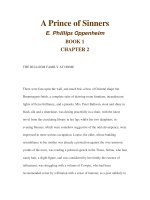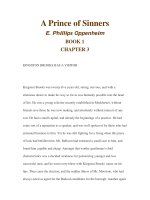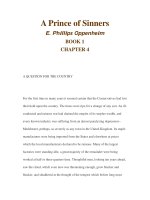Hamlet, prince of denmark
Bạn đang xem bản rút gọn của tài liệu. Xem và tải ngay bản đầy đủ của tài liệu tại đây (98.17 KB, 12 trang )
Revenge in Hamlet
Part A: Introduction
In the 15
th
– 16
th
centuries capitalist relation began to develop in Europe.
The former townspeople became the bourgeoisie. The bourgeoisie fought
against feudalism because held back the development of capitalism.
The decay of feudalism and the development of capitalist relation were
followed by a great rise in the cultural life of Europe. There was an attempt at
creating a new culture which would be free from the limitation of the feudal
ideology of the middle Ages. The epoch was characterized by a thirst for
knowledge and discoveries, by a powerful development of individuality.
There was a revival of interest in the ancient culture of Greece and
Rome (“Renaissance” is French for “rebirth”).The study of the works of
ancient philosophers, writers, and artists helped the people to widen their
outlook, to know the world and man’s nature. On the basis of both the ancient
culture and the most progressive elements of the culture of the Middle Ages
the fine arts, literature and science of the Renaissance began to develop. The
culture of the Renaissance was, in fact, the first stage of bourgeois culture.
The bourgeoisie as a class was being born and, as Engel said, the men who
founded the modern rule of the bourgeoisie had anything but bourgeois
limitations.
The most outstanding dramatist of the period, as well as of all time, was
William Shakespeare. He was born on April 23, 1564 in the small town of
Stratford-upon-Avon, about seventy-five miles from London. He was the son
of a tradesman. When a boy he went to Stratford Grammar School where
Latin and Greek were almost the only subjects. Life itself, contact with people
and his acquaintance with the rich English folklore gave him more than the
scholastic methods used at school. In those says Stratford-upon-Avon was
often visited by traveling groups of actors. It is quite possible that
Shakespeare saw some plays performed by such actors and was impressed by
them.
1
Revenge in Hamlet
Shakespeare lived in Stratford-upon-Avon until he was twenty-one. By
that time he was married and had three children. At twenty-one he left
Stratford-upon-Avon for London where he joined a theatrical company and
worked as an actor and a playwright.
In the late 90s a new theatre called The Globe was built on the bank of
the Thames. Shakespeare became one of its owners. The people of the
London liked it better than any other theatre. It was in The Globe that most of
Shakespeare‘s plays were staged at that time.
In 1613, Shakespeare left London and returned to his native town of
Stratford-upon-Avon. Three years later, on April 23, 1616, he died and was
buried there. Shakespeare wrote the famous 154 sonnets and numerous highly
successful often quoted dramatic works including the tragedy “Hamlet, Prince
of Denmark.”.
Shakespeare’s Hamlet is a complex play where many themes are
intertwined – themes that are essential to the development of the play. The
issue of death and disease, both physical and emotional is very prevalent
throughout the duration of the play, as well as fate and divine providence. The
play also questions madness and whether it can be feigned, as well as
corruption and its moral implications. Of course, who could forget the famous
‘To be or not to be’ soliloquy, where Hamlet not only questions life and
death, but many of life’s other uncertainties as well.
Undoubtedly, the most essential theme in the development of Hamlet is
revenge and question ‘Does revenge pay?’ Revenge is a frighteningly
bloodthirsty emotion, which causes people to act blindly and without reason.
Revenge is a theme that is cleverly built upon throughout the extent of the
play; with it being the driving force behind two of the main characters in the
play.
2
Revenge in Hamlet
Part B: Development
I. Summary of the work.
Hamlet, written around 1600, is Shakespeare’s longest play, and among
the most powerful and influential tragedies in the English language. It
provides a storyline capable of “seemingly endless retelling and adoption by
others”. The play, set in Denmark, recounts Prince Hamlet mourns both his
father’s death and his mother, Queen Gertrude’s remarriage to Claudius. The
ghost of Hamlet’s father appears to him and tells him that Claudius has
poisoned him. Hamlet swears revenge. He arranges an old play whose story
has a parallel to that of Claudius. Hamlet’s behavior is considered mad. His
skills the eavesdropping Polonius, the court chamberlain, by thrusting his
sword through a curtain. Polonius’s son Laertes returns to Denmark to avenge
his father’s death. Polonius‘s daughter Ophelia loves the Prince but his brutal
behavior drives her to madness. Ophelia dies by drowning. A duel takes place
and ends with the death of Gertrude, Laertes, Claudius and Hamlet.
II. Analysis
The play is introduced by the appearance of the ghost of Hamlet’s father
in the first scene, which automatically gives the impression that something is
amiss. This is later clarified by the statement that
“Something is rotten in the state of Denmark”
(Act 1 Scene 4)
The ghost emerges before Hamlet and insinuates that his death was not as
innocent as it may seem. The ghost urges Hamlet to
“Revenge his foul and most unnatural murder”
(Act 1 Scene 5)
And informs him that
“The serpent that did sting thy father’s life now wears his crown”
(Act 1 Scene 5)
3
Revenge in Hamlet
This appears to indicate that Hamlet’s father’s death was actually murder, and
that the deed was committed by King Hamlet’s brother, Claudius, who had
now taken over as King of Denmark. The Ghost taunts Hamlet, telling him
that it is part of every man’s honor to avenge his death. Hamlet then becomes
a part of Denmark’s foulness and wretchedness when he agrees to avenge his
father’s death. This is the beginning of a vicious cycle of hatred, death and
revenge that destroys many lives.
Soon after Claudius marries Hamlet’s mother, Gertrude, Hamlet feigns
madness as a ploy to cover up his attempts to avenge his father’s death and to
bring him closer to Claudius. One of the first things Hamlet does in his
attempt to prove Claudius’ guilt is to have ‘The Mousetrap’ performed in
court. ‘The Mousetrap’ recreates a similar scenario as the one that had
occurred when Hamlet’s father was murdered. Hamlet was waiting for a
reaction from Claudius that would prove the ghost’s message.
Following the King’s outburst after watching the performance, Hamlet
confronted his mother and began to insult her infidelity to her dead husband.
Meanwhile, Polonius, a faithful member of the King’s council, was hiding
behind a decorate rug that was adorning the wall in Gertrude’s room. Hamlet
sensed his presence and thinking that it was Claudius, plunged his dagger
through the rug.
This causes much grief and sadness for many people. During this
period, Hamlet treats his ‘girlfriend’ Ophelia (Polonius’ daughter) in a
shocking manner, calling her a whore and denying her his love. This, coupled
with her father’s death causes her to go mad and eventually commit suicide.
This was a particularly sad death because Ophelia was just an innocent
bystander in a cruel plot for revenge. Also hurt was Laertes (Polonius’ son).
Laertes believes that it was the king that killed his father, but the king quickly
puts Laertes on Hamlets trail and pushes him to avenge his father’s murder.
4
Revenge in Hamlet
From this point on, Hamlet and Laertes become the main characters in the
play - two characters driven by revenge.
Meanwhile, Hamlet is still talking about all his plans for revenge.
During act 2, Hamlet realizes his acts of revenge so far have been through
word rather than deed.
“O, vengeance!
Why, what an ass am I! This is most brave,
That I, the son of a dear father murdered,
Prompted to my revenge by heaven and hell,
Must, like a whore, unpack my heart with words,
And fall a-cursing, like a very drab,
A stallion! Fie upon’t! foh!”
(Act 2 Scene 2)
Despite this, Hamlet continues only to speak about his plans for
revenge, and never puts any of his ideas in to practice until the last scene. At
one stage Hamlet had a perfect chance to kill Claudius whilst he was praying.
“Now might I do it pat, now he is praying,
And now I'll do it. And so he goes to heaven,
And so am I revenged. That would be scanned:
A villain kills my father, and for that,
I, his sole son, do this same villain send
To heaven.
O, this is hire and salary, not revenge.
He took my father grossly, full of bread,
With all his crimes broad blown, as flush as May;
And how his audit stands who knows save heaven?
But in our circumstance and course of thought
‘Tis heavy with him: and am I then revenged
To take him in the purging of his soul,
5
Revenge in Hamlet
When he is fit and seasoned for his passage?
No!
Up, sword; and know thou a more horrid hent.”
(Act 3 Scene 3)
Hamlet decides that if he were to kill Claudius during prayer, Claudius
would be sent to heaven, which would not be the proper revenge he seeks, so
instead, Hamlet decides to wait and take his life at a time he is in sin. Hamlet
hesitates and analyses the situation of each assassination opportunity in a
likewise manner. Perhaps Hamlet thinks that patience will pay off for him in
the long run, but unfortunately this is not so.
It is not until act five that revenge brings that play together. In scene 2,
Hamlet is explaining to his best friend Horatio how he had been sent to his
death in England. Two trusted advisers to the King, Rosencrantz and
Guildenstern had traveled with Hamlet to England, carrying instructions from
the King for Hamlet’s execution. In a moment of ‘brilliance’, Hamlet
substitutes the letter from one demanding the execution of Rosencrantz and
Guildenstem. Hamlet sees no immorality in this action; he simply sees it as
part of his revenge on Claudius.
Upon arriving back in Denmark, Hamlet is challenged to a duel with
Laertes, who is still powered by the need to avenge his father’s death. Hamlet
accepts, but prior to the duel he attempts to apologize to Laertes and blames
the murder on his madness. Laertes, who is still partly blinded by rage and
anger, accepts Hamlet’s apology, but says he must retain his honor. He tells
Hamlet that
“ I am satisfied in nature,
Whose motive, in this case, should stir me most
To my revenge: but in my terms of honour
I stand aloof; and will no reconcilement,
Till by some elder masters, of known honour,
6
Revenge in Hamlet
I have a voice and precedent of peace,
To keep my name ungored. But till that time,
I do receive your offered love like love,
And will not wrong it.”
(Act 5 scene 2)
The pair prepare for their duel, and Laertes selected a sword or “foil” with a
poisoned tip. This shows that Laertes was still not thinking straight because
he would have realized that choosing such a sword could proved dangerous
for him as well.
Meanwhile, the King Claudius is announcing that he will toast each of
Hamlet’s hits. He accepts a flagon of wine for Hamlet and poisons it at the
same time, although no one is aware of it. He also places a valuable pearl in
the wine, as an extra incentive for Hamlet to drink from it. The duel began,
with Hamlet gaining a hit against Laertes. The King attempted to get Hamlet
to drink from the poisoned cup, but Hamlet denied the wine and Queen
Gertrude was the first to drink from the poisoned cup. She falters away and
the fencing bout continued.
Laertes struck a blow against Hamlet with the tip of his poisoned sword,
but the duel continued and the swords got swapped. The next hit was made by
Hamlet, who had the poisoned sword at that point in time. Just then the Queen
collapses and the King attempts to cover it up by announcing that she doesn’t
like the sight of blood. The Queen denies this and tells the court that it was
“No,no,the drink,the drink,O my dear Hamlet,
The drink, the drink! I am poisoned.”
(Act 5 Scene 2)
At that point Laertes realizes that he has been used by the King and tells
Hamlet that he will soon die, because his sword was poisoned too, and that
the King was to blame.
7
Revenge in Hamlet
Finally, Hamlet has set the scene for the revenge that he has been
craving. He attacks the King, pushing him over, and picks up the poisoned
wine. He forces it down the King’s throat, yelling “Here, thou incestuous,
murderous, damned Dane, Drink off this potion. Is thy union here? Follow my
mother.” Laertes dies, content that justice has been served and Hamlet himself
dies soon after, his father’s death finally avenged.
8
Revenge in Hamlet
Part C: Conclusion
The obsession and need for revenge displayed by our two main
characters eventually led them both to their downfall. Not only did it hurt
themselves, but many others close to them. Ophelia’s death, for example
could be blamed on Hamlet’s desire for revenge, whilst Hamlets death
occurred as a result of Laertes quest to avenge his father’s death.
Hopefully, it is easy to see why I believe that revenge is the core
theme in Shakespeare’s Hamlet. Revenge shapes the entire plot of the play
and could be blamed for corrupting Hamlet and Laertes, making them almost
evil in their final intentions. Shakespeare highlights the moral implications of
revenge, and how a person can be corrupted by their need for revenge. The
age-old saying ‘An eye for an eye, a tooth for a tooth’ is outlined perfectly in
Hamlet. You cannot receive a punch, return a punch and then all sit down
together for a lovely dinner. The second that you retaliate, it starts a horrible
chain that is almost impossible to break.
Therefore, we need to look past what others do and try to show them
why it is wrong and how they not only hurt others, but themselves as well.
When we become one as the human race, then we shall be able to move out of
the rut we have been in for centuries. “How we approach other people
determines how quickly we evolve, how quickly our life questions are
answered. You must be completely open as are the people who bring you
messages. They will help you by opening you up. And they will fill you with
warmth and energy.” (The Celestine Prophecy) .
9
Revenge in Hamlet
References
Books:
• An introduction to English and American Literature. (2008).Hanoi.
Internet sites:
• />• />• o/shakespeare-play-hamlet.htm
10
Revenge in Hamlet
11
Revenge in Hamlet
12









